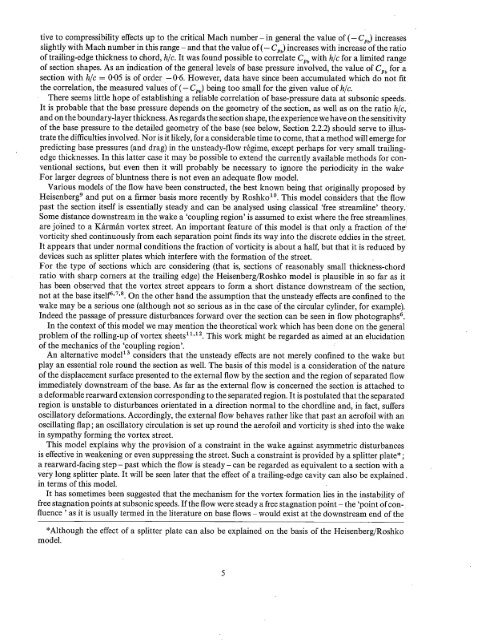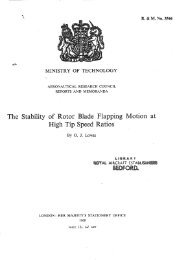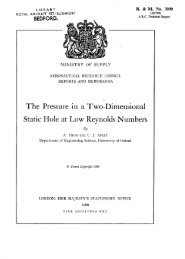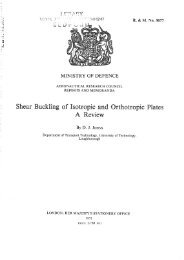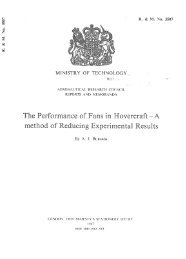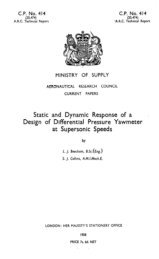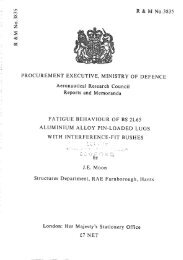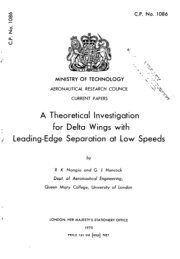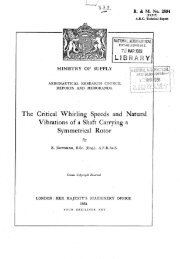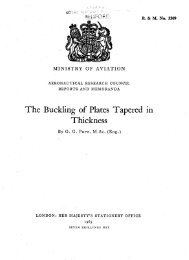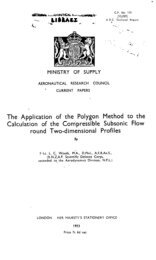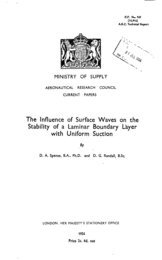A Discussion of Two-Dimensional Turbulent Base Flows - aerade
A Discussion of Two-Dimensional Turbulent Base Flows - aerade
A Discussion of Two-Dimensional Turbulent Base Flows - aerade
Create successful ePaper yourself
Turn your PDF publications into a flip-book with our unique Google optimized e-Paper software.
tive to compressibility effects up to the critical Mach number- in general the value <strong>of</strong> (-Cvb ) increases<br />
slightly with Mach number in this range - and that the value <strong>of</strong> (- Cpb) increases with increase <strong>of</strong> the ratio<br />
<strong>of</strong> trailing-edge thickness to chord, h/c. It was found possible to correlate Cpo with h/c for a limited range<br />
<strong>of</strong> section shapes. As an indication <strong>of</strong> the general levels <strong>of</strong> base pressure involved, the value <strong>of</strong> C w for a<br />
section with h/c = 0.05 is <strong>of</strong> order -0.6. However, data have since been accumulated which do not fit<br />
the correlation, the measured values <strong>of</strong> (- Cpb ) being too small for the given value <strong>of</strong> h/c.<br />
There seems little hope <strong>of</strong> establishing a reliable correlation <strong>of</strong> base-pressure data at subsonic speeds.<br />
It is probable that the base pressure depends on the geometry <strong>of</strong> the section, as well as on the ratio h/c,<br />
and on the boundary-layer thickness. As regards the section shape, the experience we have on the sensitivity<br />
<strong>of</strong> the base pressure to the detailed geometry <strong>of</strong> the base (see below, Section 2.2.2) should serve to illus-<br />
trate the difficulties involved. Nor is it likely, for a considerable time to come, that a method will emerge for<br />
predicting base pressures (and drag) in the unsteady-flow r6gime, except perhaps for very small trailing-<br />
edge thicknesses. In this latter case it may be possible to extend the currently available methods for con-<br />
ventional sections, but even then it will probably be necessary to ignore the periodicity in the wake<br />
For larger degrees <strong>of</strong> bluntness there is not even an adequate flow model.<br />
Various models <strong>of</strong> the flow have been constructed, the best known being that originally proposed by<br />
Heisenberg 9 and put on a firmer basis more recently by Roshko 1°. This model considers that the flow<br />
past the section itself is essentially steady and can be analysed using classical 'free streamline' theory.<br />
Some distance downstream in the wake a 'coupling region' is assumed to exist where the free streamlines<br />
are joined to a K~irm~n vortex street. An important feature <strong>of</strong> this model is that only a fraction <strong>of</strong> the:<br />
vorticity shed continuously from each separation point finds its way into the discrete eddies in the street.<br />
It appears that under normal conditions the fraction <strong>of</strong> vorticity is about a half, but that it is reduced by<br />
devices such as splitter plates which interfere with the formation <strong>of</strong> the street.<br />
For the type <strong>of</strong> sections which are considering (that is, sections <strong>of</strong> reasonably small thickness-chord<br />
ratio with sharp corners at the trailing edge) the Heisenberg/Roshko model is plausible in so far as it<br />
has been observed that the vortex street appears to form a short distance downstream <strong>of</strong> the section,<br />
not at the base itself 6'7'8. On the other hand the assumption that the unsteady effects are confined to the<br />
wake may be a serious one (although not so serious as in the case <strong>of</strong> the circular cylinder, for example).<br />
Indeed the passage <strong>of</strong> pressure disturbances forward over the section can be seen in flow photographs 6.<br />
In the context <strong>of</strong> this model we may mention the theoretical work which has been done on the general<br />
problem <strong>of</strong> the rolling-up <strong>of</strong> vortex sheets 11,12. This work might beregarded as aimed at an elucidation<br />
<strong>of</strong> the mechanics <strong>of</strong> the 'coupling region'.<br />
An alternative modeP 3 considers that the unsteady effects are not merely confined to the wake but<br />
play an essential role round the section as well. The basis <strong>of</strong> this model is a consideration <strong>of</strong> the nature<br />
<strong>of</strong> the displacement surface presented to the external flow by the section and the region <strong>of</strong> separated flow<br />
immediately downstream <strong>of</strong> the base. As far as the external flow is concerned the section is attached to<br />
a deformable rearward extension corresponding to the separated region. It is postulated that the separated<br />
region is unstable to disturbances orientated in a direction normal to the chordline and, in fact, suffers<br />
oscillatory deformations. Accordingly, the external flow behaves rather like that past an aer<strong>of</strong>oil with an<br />
oscillating flap; an oscillatory circulation is set up round the aer<strong>of</strong>oil and vorticity is shed into the wake<br />
in sympathy forming the vortex street.<br />
This model explains why the provision <strong>of</strong> a constraint in the wake against asymmetric disturbances<br />
is effective in weakening or even suppressing the street. Such a constraint is provided by a splitter plate* ;<br />
a rearward-facing step - past which the flow is steady- can be regarded as equivalent to a section with a<br />
very long splitter plate. It will be seen later that the effect <strong>of</strong> a trailing-edge cavity can also be explained,<br />
in terms <strong>of</strong> this model.<br />
It has sometimes been suggested that the mechanism for the vortex formation lies in the instability <strong>of</strong><br />
free stagnation points at subsonic speeds. If the flow were steady a free stagnation point - the 'point <strong>of</strong> con-<br />
fluence ' as it is usually termed in the literature on base flows - would exist at the downstream end <strong>of</strong> the<br />
*Although the effect <strong>of</strong> a splitter plate can also be explained on the basis <strong>of</strong> the Heisenberg/Roshko<br />
model.


